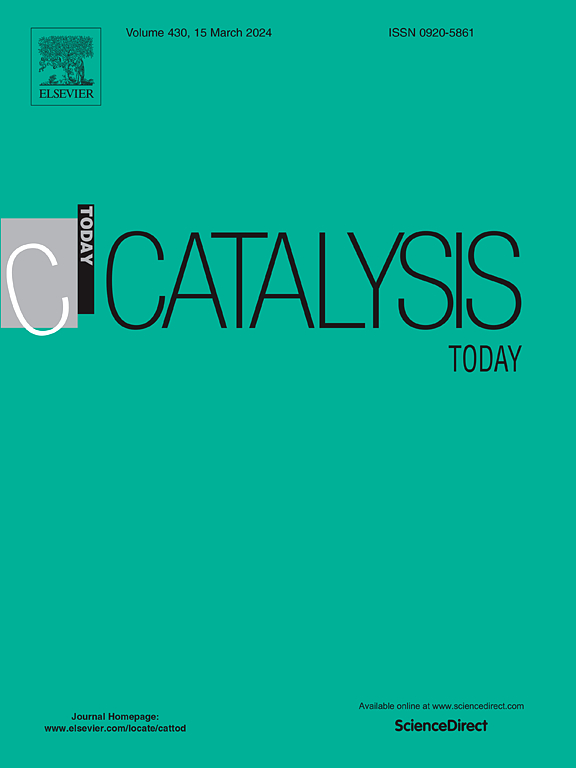Current understanding of Oxidative Coupling of Methane (OCM) reaction over supported Mn-Na2WO4 catalysts
IF 5.2
2区 化学
Q1 CHEMISTRY, APPLIED
引用次数: 0
Abstract
This perspective reviews the current understanding of the Oxidative Coupling of Methane (OCM) reaction over the supported Mn-Na2WO4/SiO2 catalyst, with a focus on recent insights gained from state-of-the-art in-situ and operando spectroscopic characterization and chemical probe experiments under controlled environments. The supported Mn-Na2WO4/SiO2 catalyst exhibits dynamic structural changes during the OCM reaction, involving multiple reactive lattice and adsorbed oxygen species, each associated with different oxide phases. These oxygen species play distinct roles in various steps of the OCM mechanism. The catalytic active sites for activation of CH4 are associated with isolated surface Na-WOx sites on the SiO2 support and the role of surface MnOx sites on SiO2 is to oxidatively dehydrogenate C2H6 to C2H4. This paper provides a detailed discussion of these roles and also introduces new experimental data from Temporal Analysis of Products (TAP) studies to clarify the ongoing debate in the literature regarding the contributions of lattice versus adsorbed oxygen species in OCM reaction product formation. Additionally, recommendations are offered for optimizing the performance of supported Mn-Na2WO4/SiO2 catalysts to enhance CH4 activation and C2 product selectivity.
负载型Mn-Na2WO4催化剂上甲烷(OCM)氧化偶联反应的研究进展
本观点回顾了目前对负载型Mn-Na2WO4/SiO2催化剂上甲烷氧化偶联反应的理解,重点介绍了最新的原位和操作光谱表征以及受控环境下的化学探针实验。负载型Mn-Na2WO4/SiO2催化剂在OCM反应过程中表现出动态的结构变化,涉及多个反应晶格和吸附的氧,每种氧都与不同的氧化相相关联。这些氧在OCM机制的各个步骤中发挥着不同的作用。CH4活化的催化活性位点与SiO2载体上分离的表面Na-WOx位点有关,SiO2表面MnOx位点的作用是将C2H6氧化脱氢为C2H4。本文对这些作用进行了详细的讨论,并介绍了来自产品时间分析(TAP)研究的新实验数据,以澄清文献中关于晶格氧和吸附氧在OCM反应产物形成中的作用的争论。此外,还提出了优化负载型Mn-Na2WO4/SiO2催化剂性能的建议,以提高CH4活化和C2产物选择性。
本文章由计算机程序翻译,如有差异,请以英文原文为准。
求助全文
约1分钟内获得全文
求助全文
来源期刊

Catalysis Today
化学-工程:化工
CiteScore
11.50
自引率
3.80%
发文量
573
审稿时长
2.9 months
期刊介绍:
Catalysis Today focuses on the rapid publication of original invited papers devoted to currently important topics in catalysis and related subjects. The journal only publishes special issues (Proposing a Catalysis Today Special Issue), each of which is supervised by Guest Editors who recruit individual papers and oversee the peer review process. Catalysis Today offers researchers in the field of catalysis in-depth overviews of topical issues.
Both fundamental and applied aspects of catalysis are covered. Subjects such as catalysis of immobilized organometallic and biocatalytic systems are welcome. Subjects related to catalysis such as experimental techniques, adsorption, process technology, synthesis, in situ characterization, computational, theoretical modeling, imaging and others are included if there is a clear relationship to catalysis.
 求助内容:
求助内容: 应助结果提醒方式:
应助结果提醒方式:


